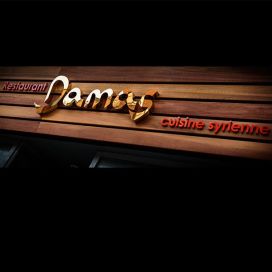On Saturday, May 19, Damas will be welcoming Lebanese winemaker Faouzi Issa from Domaine des Tourelles.
While Faouzi is a young winemaker, the domaine has been producing wine since 1868 – it’s as old as Canada!
Francois-Eugene Brun, a French engineer, founded the winery in the Bekaa Valley, in the town of Chtaura in the 1860s. It remained in the family until 1999 when Pierre L. Brun died. Faouzi’s father was a close friend of the Brun’s, and purchased the vineyard and caves soon after.
If you recognize the name Brun, this is because the vineyard has long distilled it’s own wine into the famous ARAK BRUN, a delicious and celebrated Arak.
Arak Brun is special because the domain uses only its own grapes, especially the indigenous Obeideh varietal, for the spirit. He has also begun farming aniseed specifically for his own Arak. The Arak is three times distilled in traditional copper alembics that preserve the complexity of the base mash rather than masking it as an industrial column still does. The Arak is aged in clay amphora for at least 12 months in a 100 year old cellar before bottling.
While the Arak is legendary and the best of its kind, it is the wine being produced by Faouzi Issa that is most exciting for us today. Faouzi earned a degree from the American University of Beirut before heading to France for a Masters in Winemaking in Montpellier and stages at two legendary French domaines: Réné Rostaing in the Northern Rhône and Château Margaux in Bordeaux. He then returned to Lebanon and took over the wine program at Tourelles from the Europeans his father had hired.
Only a decade in, Faouzi has already proven himself to be the visionary of Lebanese wine. Organic viticulture is assumed: due to the heat and soils of the Bekaa Valley, pesticides and herbicides are not necessary to begin with. But he goes further than simply farming organically: he is working with very little intervention in order to best exemplify the Bekaa’s unique terroir.
The basic red and white cuvées are far from basic: fermented with indigenous yeasts and without oak influence, their aromatics are unique and pure. The white is housed in stainless steel. Mostly Viognier with Chardonnay and the Mediterranean varietals Muscat d’Alexandrie (aka Zibibbo) and Obeideh (Lebanon’s own varietal), the wine shows honeyed pineapple, jasmine, and not is not as light as it might first seem. A nice weight on the palate while remaining fresh and crisp. Low acidity but with a slightly bitter finish that recalls Rhône whites.
The red ferments spontaneously in century old concrete vats and continues to age there.While certainly showing the classic dark fruit of a Cabernet/Syrah, it also accentuates the tertiary flavours associated with those grapes: Black Olive for Cabernet Sauvignon and Black Pepper for Syrah. The tannic structure is there but without any of the heaviness associated with its heavily oaked neighbours in the Bekaa.
Now we come to the Vielles Vignes, Tourelles’ 100% old vine Cinsault release. For us, it is simply the most exciting wine out of the region today, and the most exciting move in Lebanese reds since Kefraya’s Comte M broke onto the scene in the late 90s. In fact, it heralds a third era in Lebanese wines.
The first era is that of Château Musar, which was founded by Gaston Hochar in he 1930s. His son, Serge, took over in 1959 and made stunning and unique wines until his death in 2014, blending dense Cabernet Sauvignon with the perfumed Cinsaut and spicy/mineral Carignan. His wines gained legendary status in 1979 when they were chosen as the Discovery of the Fair at à Bordeaux festival. They are always well aged, elegant, complex, mysterious, and challenging.
The second era is represented by Chateau Kefraya’s Comte M, a wine that opposes Musar on most fronts: heavily extracted, jammy, mostly new oak, and with massive tannic power. Mysterious and challenging are not appropriate adjectives. Robert Parker, the famous American wine critic, gave the 1996 vintage 91 points, and Lebanon was in the headlines again. What was exciting about Comte M was it’s ability to compete with Bordeaux, California and Australia for big, heavily oaked Cabernet Sauvignon and Syrah: the Bekaa could drop a sledgehammer as well.
Here in 2018, what is exciting is precisely the opposite: Lebanon’s ability to make wine unlike any other. In some ways, Faouzi’s wines are a reaction against the Californication of Lebanese wines (and of wine in general). The goal is no longer mega concentration of dark fruit, tannin, and power. The goal is rather purity of fruit and aromatics that speaks to the terroir from which it comes. Instead of new oak, Faouzi ferments in ancient concrete and ages in used oak. Instead of industrial yeasts, Faouzi encourages the yeasts in the vineyard and the cellar, leaving a layer of dust atop the ancient concrete vats:
Dust encourages the natural yeasts that give our wines their distinctive character.”
Moreover, the wine shows the potential of Cinsault, the grape that was planted everywhere in Lebanon before being ripped up in favour of the internationally popular Bordeaux and Rhône grapes. It is as close as Lebanon has to an indigenous red grape.
Sure enough, the wine is unlike any other, and even recalls flavours well known in the regional cuisine: pomegranate juice, hibiscus, and sumac, along with other warm baking spices, morel cherries, and a nice bitter herbal spice component that cuts the ripe fruit.
Faouzi recognizes his place in the line of Lebanese winemakers:
I’m not modest; I’m known as the next Serge Hochar. I’m the youngest wine producer and yet I’m the president of the technical committee of the wineries association.’









